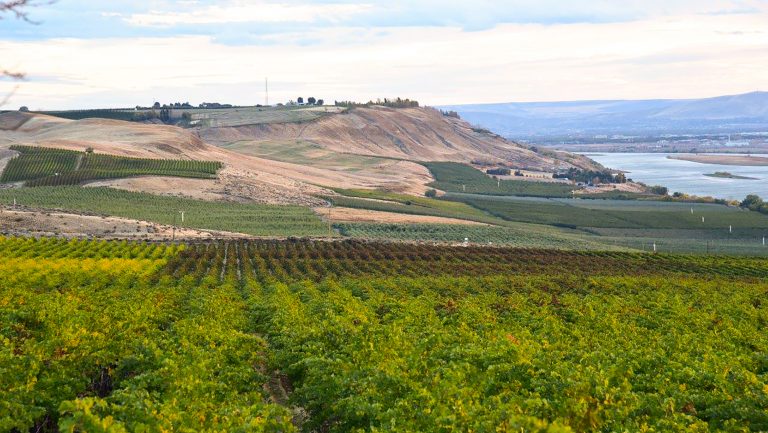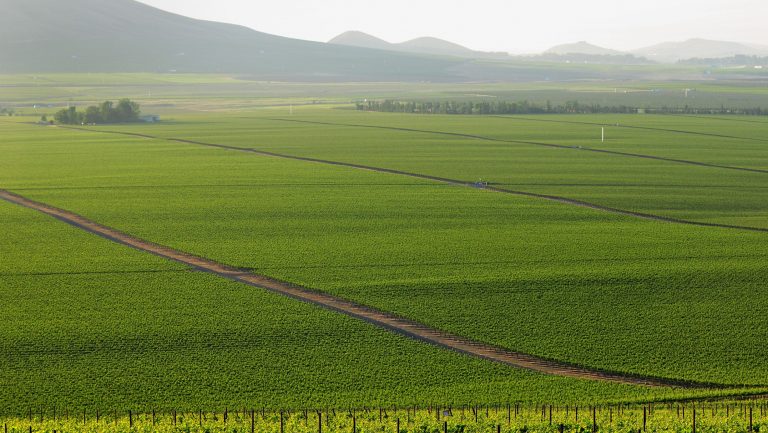As many as five new American Viticultural Area (AVA) designations may be bestowed on Washington State in the coming years, making it easier for professionals to identify a range of wines that appeal to consumers’ palates and preferences.
The Alcohol and Tobacco Tax and Trade Bureau (TTB) has accepted five petitions for distinct wine regions in the state. “At this stage they’re just what are called perfected petitions,” says Kevin Pogue, a professor of geology at Whitman College in Walla Walla who has also written several AVA applications. “They’re approved to go through the process, but they’re a long way from being completed.” The process typically takes one to two years. Should the applications be approved, here’s what to expect from the new names that’ll start appearing on wine labels.
Candy Mountain AVA
At approximately 900 acres, the proposed Candy Mountain AVA will be Washington’s smallest AVA. It includes only the south-facing slopes of Candy Mountain, which is south of Red Mountain, near the Tri-Cities. Cabernet Sauvignon, Syrah, Sangiovese, and Merlot are the AVA’s primary grape varieties.

Don’t miss the latest drinks industry news and insights. Sign up for our award-winning newsletters and get insider intel, resources, and trends delivered to your inbox every week.
“It’s showing great quality,” says Pogue. “I imagine the characteristics of the wine would be very similar to Red Mountain because the soils are quite similar. However, Candy Mountain is equivalent to the best of what’s on Red Mountain.”
“The soil profile is unique,” says Gilles Nicault, the winemaker at Long Shadows Vintners in Walla Walla. “You see a lot of fractured granite out there. It’s a very nice soil profile with lots of minerality.” Of the grapes, he says, “There’s very nice maturation that brings very nice color to the wine and, at the same time, just an incredible flavor profile. It’s definitely a warmer site, so the fruit has a riper style, which really brings that vibrant character and richness and backbone to the fruit.”
Goose Gap AVA
Goose Gap is a few miles west of the Tri-Cities and borders the Red Mountain AVA. Alan Busacca, the owner of Vinitas Vineyard Consultants, based in Othello, notes that while most plantings near Goose Gap are on south and southeast-facing slopes, the only farmable land on the AVA’s namesake Goose Hill is on the north and northeast faces. That leads to different sun exposure and climate conditions.
“Because of the more gentle northerly facing slopes, we preserve a lot of freshness and crispness in the wines,” says Andrew Wilson, the head winemaker for Goose Ridge Vineyards and Winery, based in Benton City. “Even with the Merlot and Cabernet, there are a lot of really clean, bright flavors. If you compare [Goose Gap] with an AVA like Candy Mountain or Red Mountain, that has these big tannin structures, our wines can have the tannins but not so much the big, ripe, jammy fruit.” Plantings in this area are predominantly Chardonnay, Merlot, Syrah, and Cabernet Franc.
Royal Slope AVA
Royal Slope is east of Ellensburg in the Frenchman Hills section of the Yakima Fold Belt. “It shares a really favorable grape-growing climate with quite a large area in Eastern Washington that’s in a bull’s-eye of rain shadow,” Busacca says. A modest elevation, however, puts it high enough to escape the cold air that sometimes settles in the valleys. Frequent winds keep the air fresh and clean, and a range of soil types allows growers to experiment with the best soil-clone combinations. The proposed AVA covers 250 square miles and produces about 20 grape varieties, including Syrah, Cabernet Franc, Chardonnay, Merlot, and Riesling.

The Burn of the Columbia AVA
“On the older maps, this area was designated as The Burn,” says John Derrick, the vice president of vineyards for Mercer Ranches, based in Prosser. “What they used to do is burn [the grasses] off once a year to let them regrow. The early settlers did [this], and they talked as if it was a Native American practice as well.” The AVA’s southern border is a section of the Columbia River in Klickitat County near the town of Sundale. The AVA comes to a point—like the tip of a triangle—in the north at the borders of the Yakima Nation. This AVA will carve out a section of the Columbia Valley AVA, claiming it as its own.
The Burn covers 16,000 acres of warm, windy ground with a variety of soils. The most commonly grown grapes are relatively new plantings of Malbec, Cabernet Sauvignon, Syrah, and Chardonnay, with a little Sangiovese being grown on older vines. One of the notable early wines from the area is Chateau Ste. Michelle’s Borne of Fire, a Cabernet Sauvignon that received a 96-point rating in May 2018 from James Suckling.
White Bluffs AVA
The White Bluffs near the Tri Cities get their name from the layers of pale sediment embedded in the soil. These massive land formations have good air drainage, good sun exposure, and warmer temperatures, which make them excellent for growing grapes, says Kent Waliser, the director of vineyard operations at Sagemoor Vineyards, based in Pasco.

The area produces mostly Cabernet, Merlot, Chardonnay, Riesling, and Syrah. “What we largely see in the red varieties is an elegance and softness of tannins and ripeness of fruit,” says Waliser. “It’s maybe not as hot as Red Mountain, so the wines typically don’t have the same tannin structure, but they’re not wimpy wines. They age well even with the softer tannins.” The white wines, he adds, tend to hold acidity well.
Pogue points out that grapes have been growing in this area since the 1970s. “It will be known,” he says, “as a place for producing classically styled Bordeaux wines that will have great complexity because of the age of the vines and the [conditions in the] area.”

Dispatch
Sign up for our award-winning newsletter
Don’t miss the latest drinks industry news and insights—delivered to your inbox every week.
Sophia McDonald is a freelance writer who lives in Eugene, Oregon. Her work has appeared in numerous publications and on websites, including Wine Enthusiast, Eating Well, Sip Northwest, and 1859 Oregon’s Magazine.







